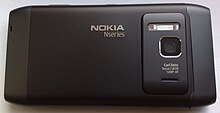Cameras on cell phones proved popular right from the start, as indicated by the J-Phone in Japan having had more than half of its subscribers using cell phone cameras in two years. The world soon followed. In 2003, more camera phones were sold worldwide than stand-alone digital cameras largely due to growth in Japan and Korea.[47] In 2005, Nokia became the world's most sold digital camera brand. In 2006, half of the world's mobile phones had a built-in camera.[citation needed] In 2006, Thuraya released the first satellite phone with an integrated camera. The Thuraya SG-2520 was manufactured by Korean company APSI and ran Windows CE. In 2008, Nokia sold more camera phones than Kodak sold film-based simple cameras, thus becoming the biggest manufacturer of any kind of camera.[citation needed] In 2010, the worldwide number of camera phones totaled more than a billion. Since 2010, most mobile phones, even cheapest ones, are being sold with a camera. High-end camera phones usually had a relatively good lens and high resolution
Cameras on cell phones proved popular right from the start, as indicated by the J-Phone in Japan having had more than half of its subscribers using cell phone cameras in two years. The world soon followed. In 2003, more camera phones were sold worldwide than stand-alone digital cameras largely due to growth in Japan and Korea.[47] In 2005, Nokia became the world's most sold digital camera brand. In 2006, half of the world's mobile phones had a built-in camera.[citation needed] In 2006, Thuraya released the first satellite phone with an integrated camera. The Thuraya SG-2520 was manufactured by Korean company APSI and ran Windows CE. In 2008, Nokia sold more..
.
Higher resolution camera phones started to appear in the 2010s. 12-megapixel camera phones have been produced by at least two companies.[49][50] To highlight the capabilities of the Nokia N8 (Big CMOS Sensor) camera, Nokia created a short film, The Commuter,[51] in October 2010. The seven-minute film was shot entirely on the phone's 720p camera. A 14-megapixel smartphone with 3× optical zoom was announced in late 2010.[52] In 2011, the first phones with dual rear cameras were released to the market but failed to gain traction. Originally, dual rear cameras were implemented as a way to capture 3D content, which was something that electronics manufacturers were pushing back then. Several years later, the release of the iPhone 7 would popularize this concept, but instead using the second lens as a wide angle lens.[53][54][55][56][57][58] In 2012, Nokia announced Nokia 808 PureView. It features a 41-megapixel 1/1.2-inch sensor and a high-resolution f/2.4 Zeiss all-aspherical one-group lens. It also features Nokia's PureView Pro technology, a pixel oversampling technique that reduces an image taken at full resolution into a lower resolution picture, thus achieving higher definition and light sensitivity, and enables lossless zoom. In mid-2013, Nokia announced the Nokia Lumia 1020. In 2014, the HTC one M8 introduced the concept of having a camera as a depth sensor. In late 2016, Apple introduced the iPhone 7 Plus, one of the phones to popularize a dual camera setup. The iPhone 7 Plus included a main 12 MP camera along with a 12 MP telephoto camera which allowed for 2x optical zoom and Portrait Mode for the first time in a smartphone. In early 2018 Huawei released a new flagship phone, the Huawei P20 Pro, with the first triple camera lens setup. Making up its three sensors (co-engineered with Leica) are a 40 megapixel RGB lens, a 20 megapixel monochrome lens, and an 8 megapixel telephoto lens. Some features on the Huawei P20 Pro include 3x optical zoom, and 960 fps slow motion. In late 2018, Samsung released a new mid-range smartphone, the Galaxy A9 (2018) with the world's first quad camera setup. The quadruple camera setup features a primary 24MP f/1.7 sensor for normal photography, an ultra-wide 8MP f/2.4 sensor with a 120 degrees viewing angle, a telephoto 10MP f/2.4 with 2x optical zoom and a 5MP depth sensor for effects such as Bokeh. Nokia 9 PureView was released in 2019 featuring penta-lens camera system.[59]
In 2019, Samsung announced the Galaxy A80, which has only rear cameras. When the user wants to take a selfie, the cameras automatically slide out of the back and rotate towards the user. This is known as a pop-up camera, and it allows smartphone displays to cover the entire front of the phone body without a notch or a punch hole on the top of the screen. Samsung, Xiaomi, OnePlus, and other manufacturers adopted a system where the camera "pops" out of the phone's body.[60][61] Also in 2019, Samsung developed and began commercialization of 64 and 108-megapixel cameras for phones. The 108 MP sensor was developed in cooperation with Chinese electronics company Xiaomi and both sensors are capable of pixel binning, which combines the signals of 4 or 9 pixels, and makes the 4 or 9 pixels act as a single, larger pixel. A larger pixel can capture more light (resulting in a higher ISO rating and lower image noise).[62][63][64] Under display cameras are under development, which would place a camera under a special display that would allow the camera to see through the displayThis new best Trailer in2021 Look. Camera, Price, 7000mAh.Battery its Osame ------ (propertyiphone.blogspot.com)



Comments
Post a Comment